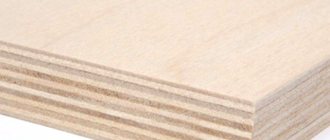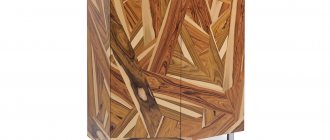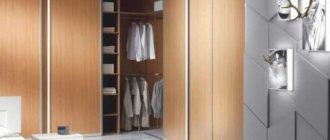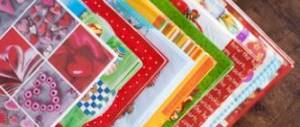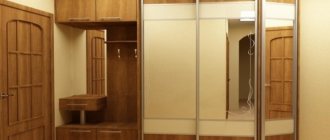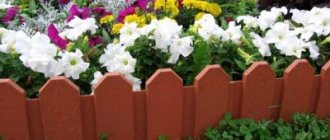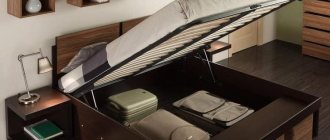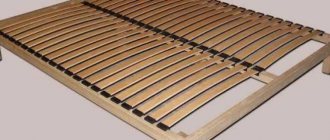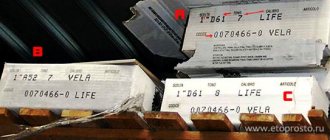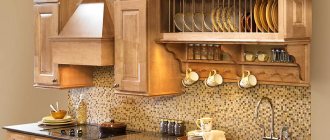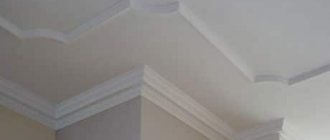Reconstructed veneer
Advances in technology have led to the production of veneers dyed to the full thickness. This made the creation of reconstituted veneer (sometimes called "reclaimed veneer") possible.
To produce reconstituted veneer, wood from fast-growing trees from controlled reforestation areas is used (for example, Italian poplar and Cameroon ayus are used).
Many thin layers of rotary-cut veneer, individually dyed, are glued into a stack using a special technology in such a way that a reconstructed solid is obtained, from which reconstructed veneer is then produced by planing.
| Rice. 8. Reconstructed veneer |
One of the advantages of reconstructed veneer is that it has its own face with a clearly defined structure, pattern and color, most suitable for modern trends and fashion in the production of doors, furniture, and so on.
Fine-line and multi-veneer veneer
Fine-line is a type of reconstructed veneer made from natural wood that imitates certain species.
| Rice. 9. Fine-line veneer |
Features of fine-line veneer sanding
It is recommended to sand fine-line veneer in 2 passes. In the 1st pass, use skins with a grain size of 90-120 (surface leveling), and in the 2nd pass, a grain size of 150-180.
Keep in mind that fine-line veneer is thinner and softer than traditional veneer.
Multi-veneer is a reconstructed veneer made of natural wood, creating the effect of a harmonious combination of given color shades in a simple or complex pattern.
What are the benefits of reconstituted veneer?
The main advantage of reconstructed veneer is its uniformity over a large area (sheets of reconstructed veneer can have dimensions of about 3 m by 1 m), which allows you to bypass the stage of “stitching shirts” from strips, repeatability of decorative and geometric features.
This allows the use of veneer with virtually no waste and significantly reduces the duration of veneering technological stages.
What are the features of painting reconstructed veneer?
Compared to traditional natural veneer, reconstructed veneer is an even more porous and less hard material. The pores in the reconstructed veneer may not be straight, but tortuous, and contain glue, which may require a special technology for filling them.
To increase the uniformity of paint and varnish application on reconstructed veneer, it is sometimes necessary to apply special adhesive primers.
| How to distinguish reconstructed veneer from natural one? The main differences between natural and artificial veneer: The artificial veneer pattern has small structural notches (depicting wood pores), equally located on its surface at an angle of 20 degrees, as they are applied using rollers installed on a rolling machine. Despite the name of artificial veneer, be it rosewood, oak or others, the pattern upon careful examination will be the same everywhere, regardless of color. The pattern of natural veneer is not so repeatable and has pronounced growth rings, depending on the type of wood. The pattern of natural veneer will always be more clearly “alive” than that of artificial veneer, which can be more blurred “dead”. |
What is veneer...
The word veneer comes from the German – Spon, which means sliver, lining. Veneer is a natural material. It consists of thin sheets made from natural wood of various species.
Depending on the production method, veneer is called peeled (made on special peeling machines), planed or sawn veneer.
Peeled veneer (thickness 0.1 - 10 mm) is the most common, cheapest and most accessible type of veneer for consumers. Produced on peeling machines. For the production of rotary-cut veneer, wood species such as alder, birch, pine, and oak are mainly used. The technology for its production is simple - rounded short logs - logs - are cut in a spiral, forming thin chips - veneer - of a given thickness.
Sawn veneer (thickness from 1 to 10 mm), is produced on plywood sawing machines or horizontal sawmill frames. Made from coniferous wood: fir, cedar, spruce. This veneer is of particularly high quality and can be used, in particular, for the production of soundboards for violins and other stringed musical instruments. Sawn veneer is a fairly expensive material, since during its production a large amount of wood is used for sawdust.
Sliced veneer (thickness from 0.2 to 5 mm) is produced on veneer cutting machines. This type of veneer is made mainly from valuable wood species that have a beautiful texture. These are oak, beech, acacia, walnut, mahogany, Karelian birch, ash, elm, yew and others.
For different types of wood, different planing directions are chosen, depending on the effectiveness of the natural wood pattern. As a result, tangential, radial-tangential, tangential-end and radial veneers are obtained.
Veneering is gluing veneer onto a stable base (tambourate panel, MDF, chipboard, plywood, etc.).
Currently, manufacturers offer three types of veneer:
- natural,
— fine-line,
- multi-veneer.
Natural veneer.
Natural veneer is a thin sheet that is removed from solid wood by sawing, peeling, chipping or planing. This veneer is called natural because the unique texture of the wood is completely preserved during the production process. This material occupies an intermediate price position: it is cheaper than natural solid wood, but more expensive than chipboard. At the same time, natural veneer has such qualities as environmental friendliness, sophistication and unique design.
Fine-line veneer.
Fine-line veneer is a reconstructed veneer made using a special technology from natural wood with the ability to imitate various types of wood with certain sizes and different shades. The main raw material for the production of veneer using fine-line technology is wood from fast-growing tree species. Fine-line veneer is made from rotary-cut veneer by forming it into blocks, from which veneer is then produced in a variety of colors, patterns and sizes.
The technology for manufacturing this type of veneer was developed in accordance with modern environmental requirements and the need to obtain a new texture. Fine-line veneer does not replicate any of the existing wood species and has a unique, clearly defined structure, pattern and color that meet modern trends in the production of slopes, arches, portals, doors, panels, furniture, etc.
During production, wood goes through the following processing stages:
1. Peeling - logs are spread into a strip of a certain thickness, which is then cut into veneer sheets of a certain size;
2. Drying the resulting veneer sheets and sorting them by color;
3. Through staining - sorted veneer is immersed in a tank with a dye solution;
4. Gluing and pressing - painted sheets are collected into bundles with the same fiber direction and sandwiched with a binder. The adhesive composition not only binds the veneer layers to each other, but also creates an additional decorative effect by adding dye. The created pack is pressed under high pressure;
5. Planing - from the resulting block, sheets of planed veneer are obtained with a certain predetermined texture and structure.
Composition: 92 - 94% - natural wood, 7 - 8% binder (glue), 0.3 - 0.5% - dye.
Advantages: the material has a uniform predetermined pattern and color, there are no defects characteristic of natural wood - knots, knots and cavities.
Disadvantages: the material turns out to be brittle, as well as porous, and when veneering it requires a large amount of glue.
Multispon.
Multi-veneer is a specially reconstructed veneer made from natural wood. This type of veneer can be called the most “decorative”, since its appearance is often the least reminiscent of the patterns of natural wood. The main color motifs of multi-veneer are geometric patterns, often combining different color shades. Products made from this type of veneer look modern and fit perfectly into any interior in the Art Nouveau style.
The main advantages of veneered products are:
• Environmental friendliness (natural natural material)
• Impeccable appearance (rich assortment, ability to remove defects typical of solid wood)
• Ease of production (ease of manufacture, high speed of operation)
• Duration of operation (products lined with veneer do not dry out, like solid wood products, and are not afraid of humidity and temperature)
Depending on the texture of the wood and the type of cutting, sliced veneer is divided into:
- radial,
- semi-radial,
- tangential,
— tangential-end.
The length of sliced veneer sheets can be 200, 400 and 9800 mm, width - 60, 100, 120 and 200 mm, thickness - 0.4, 0.6, 0.8 and 1 mm.
There are eight grades of veneer: A, AB, B, BB, C, 1st, 2nd and 3rd. Veneer is produced in several sizes: 800–1300 mm long, 150–170 mm wide and 0.35 mm, 0.55 mm, 0.75 mm, 0.95 mm and 1.15 mm thick, and 1300–2500 mm long , width 700–2500 mm and thickness 1.5–4 mm.
Manufacturing methods
The core of the door, or its “body,” can be solid or hollow. A solid door is a solid or spliced solid pine or spruce (or any other coniferous wood). The spliced core of the canvas is made as follows: a frame is created from pine beams, the beams are laid close to each other in it. The resulting structure is sent under the press and fixed with glue. For this purpose, high temperature is rarely used, more often microwaves.
Then the future canvas is ground and calibrated. A plywood sheet or MDF is glued onto it and sent under a cold press to allow the glue to dry. Next, the wooden canvas is sent to the machine and adjusted to the desired size.
On a machine for hollowing out grooves for hinges and fittings (if the fittings are factory-fitted). After this, the door is sent to the next point for sanding, polishing and varnishing. Several such stages go through, after which the door is considered ready and sent to the factory.
A hollow sheet is made as follows: a frame is created from timber and filled with honeycomb filler - cardboard. Another common veneer option is polystyrene foam boards. The future canvas is covered with MDF boards and lined with veneer, often artificial.
Veneered canvases can be subjected to cold or hot pressing, often these two methods are combined. Self-adhesive veneer is a film that is applied to the finished canvas and does not always imitate wood. Often it resembles a marble or stone coating.
What are veneer doors?
A veneer door is a structure made of a frame, filler and veneer. It performs the same role as furniture upholstery. Under such cladding there may be a door leaf made of wood or, a more economical option, made of MDF.
Such products are popular in the construction market. They have good quality characteristics: decorative properties, durability, easy to care for and versatility. Their appearance fits organically into a classic interior, which cannot be said about plastic products. And the price of interior doors made of natural veneer is lower than that of analogues made of solid wood.
Production technology
Veneer doors consist of a frame, filler and facing layer. Two types of construction are popular: from MDF panels (economical option) and solid wood (more expensive option).
Manufacturing technology for veneered MDF doors:
- The frame is assembled from inexpensive wood, for example, pine.
- Fill with filler – corrugated cardboard;
- MDF panels are attached to the door frame;
- A layer of veneer is applied.
- Apply a layer of varnish to protect against moisture.
The process of creating products from solid wood is different in that instead of a frame, a wooden canvas is used - often assembled from small pieces. This reduces the cost.
Veneering - the technology of fixing veneer to a base - comes in two types:
Hot pressing. The veneer sheet is glued with a chemical composition containing formaldehyde at temperatures above 100 °C. This method is widely used due to its low cost.
Cold pressing. More environmentally friendly, but also expensive. They use formaldehyde-free glue, which hardens at a temperature of 30–35 °C.
These methods are used for all types of veneer in the manufacture of interior doors: this is how both natural and multi-veneer are attached.
Advantages and disadvantages
Veneered doors have their advantages and disadvantages. You need to study them before purchasing in order to make the right choice.
Advantages
The veneer covering interior doors has many advantages:
- Attractive appearance and variety of shades. Without a detailed examination, the door appears to be made of natural wood. The veneer retains its color and original pattern of fibers and knots. Unlike laminated flooring, the pattern is unique and natural.
- Affordable cost: by purchasing doors with veneer, you can save money and decorate your home with valuable wood without blowing your budget.
- Health safety, especially for cold pressed doors.
- Durability: service life reaches at least 10 years, and with careful use increases to 15–20 years. Additional coating with paints and varnishes protects the door from moisture and mechanical damage.
- Environmentally friendly. By purchasing a veneer door, a person indirectly participates in environmental protection. The production of the product requires much less wood material than a door made of solid wood. There is practically no visual difference.
All this makes veneered interior doors deservedly in demand.
Flaws
Before purchasing, you need to remember about the disadvantages of the material:
- When gluing to a door leaf using the hot pressing method, formaldehyde is used. In large quantities, vaporized substances can be toxic to humans. Therefore, you need to choose a reliable manufacturer with a good reputation who monitors the safety of their products.
- Veneer is susceptible to sunlight: its color fades in excess light.
- The material does not tolerate contact with moisture and temperature changes. It is used only in internal heated rooms.
Laminate or veneer?
Interior doors with synthetic coating on all components have recently appeared on the market and have gained great popularity in a short time. At first, this type of door was coated with melamine paper; this technology is widely known in the furniture industry. The small thickness of 0.2 millimeters of the material was perfect for covering profiles with a large radius of curvature.
This type of coating was distinguished by a plausible reproduction of the texture and color of natural wood, but it had a number of disadvantages - poor adhesion to the base, the appearance of cracks on most of the canvas, and was difficult to clean. Instead of melamine paper, they began to use two-chrome laminate, which also came from the furniture industry. Its thickness ranges from 0.2 to 0.8 millimeters, has higher aesthetic characteristics and improved resistance to external mechanical influences, which has a positive impact on its consumer properties.
But whether laminated interior doors will become popular among consumers is a rhetorical question. To have an idea about this, it is necessary to consider the advantages and disadvantages of both veneer and laminate. Then everyone will be able to independently choose one or another material for themselves.
Veneer is the most decorative facing material, for the manufacture of which natural wood is used.
Veneer: advantages: - veneer is a natural material; — the presence of a large number of different types of wood, colors and textures; — the possibility of restoration of the canvas due to damage to the integrity of the coating; — the ability to produce doors with complex inlays and complex geometry; — veneer has prestige; — veneer is mainly produced in Europe, where high quality products are guaranteed.
Veneer: disadvantages: - causing significant damage to natural sources of wood; — high costs for maintaining a constant texture and color of various door elements; — high labor intensity of covering elements with a curved profile with veneer; — significant resource costs for the production of veneer, which are reflected in its cost.
Laminate: advantages: - high quality laminate is easy to clean; — wear resistance is higher than that of veneer;
Laminate: disadvantages: - artificial origin of the film, which has nothing in common with cellulose, high-quality and pure chemistry; — the similarity of all doors, since the laminate is made in reels like film; — the surface is too smooth, Japanese manufacturers tried to add roughness to melamine paper, but the market did not respond to this; — during processing, the laminate crumbles, the same can happen with impacts. Although this kind of problem can also occur with veneer. For trimming, you must use a well-sharpened cutting tool; — the cost of high-quality imported laminate is not cheaper than veneer; — the possibility of purchasing a product made from low-grade laminate, imported from Southeast Asia to Europe in an agreement between an unscrupulous importer and the manufacturer in order to reduce the price of the product.
Conclusion: given the same price for doors, you decide which doors are better to live with: doors lined with natural veneer or laminate.
How to find out which veneer door is better and of higher quality
There is another way to diversify the collection of apartment doors, but it is used within the “veneered doors” category itself. Classification is carried out according to the type of veneer used. As you know, there are 3 of them:
- Natural (natural);
- Fine-line;
- Eco-veneer
The first is the most expensive because it is made by cutting a thin layer of wood. The same array, but in the form of a film up to 1 mm thick. The second option is also made from wood, but using a different technology. First, the wood sections are glued into one sheet of plywood and then it is cut into thin layers. Eco-veneer is made from pulp industry waste and polypropylene. Door covering materials are listed in descending order of price.
Interior door with ash veneer finish
How can an ordinary person distinguish a door made of natural veneer from eco-veneer and fine line:
- Veneer is an exact imitation of solid wood, with the same beautiful pattern and texture;
- The fine line has many repeating fragments on the surface;
- Eco-veneer is a polymer. Look at the end sections, you can see that this is a film and not a cut of wood. And the second point is that eco-veneer comes in a wide range of colors, including those that are not found in nature.
How to find out which veneer doors are better and of higher quality? Don’t be afraid to touch the canvas, even smell what it smells like. A good door has an absolutely smooth surface and no pungent chemical odors.
Which is better – doors made of solid wood or veneer?
There is an opinion that the choice between doors made of veneer and solid wood is made solely because of the price. The statement is true, but partly, and does not work in all cases. For example, models made from inexpensive solid pine may cost the same or less than beautiful paneled doors made from natural oak veneer.
Interior doors with oak veneer finish
What is better – solid wood or veneer? We suggest making a comparison based on key parameters:
- Scope of application: solid wood doors are installed in richly decorated living rooms, halls, as well as in houses and offices with luxury finishing. Veneered models are less picky about their surroundings, although in order to install a door in the middle and mid-price segment in a room, you need to comply. They are also ordered for apartments, offices, country houses, but they are not necessarily fit into exquisite interiors and expensive antiques are selected as a background;
- Moisture resistance - it is believed that veneer copes better with high humidity, although this criterion depends not so much on the material itself, but on its protection. Still, if you need a door for the bathroom, it is better to get by with veneer so as not to risk a lot of money;
- Price is the undisputed priority on the side of veneer doors. Solid wood is always more expensive than thin cut wood, although if two models are identical in design, is it worth paying more?
- The ability to eliminate defects on the surface: solid wood doors have more of them, although there are special compounds that can be used to make scratches on the veneer invisible, if not eliminated.
Another advantage of veneer doors is their low weight. Installation of solid wood products is usually carried out on three loops. In the case of veneer, reinforcement is not required.
Veneer - what is it and how is it produced?
Veneer is a layer of wood with a thickness ranging from fractions to several millimeters. It is made from various types of wood.
Production technology
To make veneer, we use high-quality healthy wood. The blanks are pre-processed:
- Soaking and steaming give the workpieces the same physical qualities throughout the entire thickness; the processing time is determined by the density and moisture content of the base.
- Drying in a special chamber is necessary for uniform drying throughout the thickness of the trunk, which cannot be obtained naturally.
- Pre-processing - the workpiece is given the appearance of a cylinder or bar, depending on the method of obtaining veneer.
The prepared workpieces are sent for sawing. Here they use equipment with precise settings, knives with a adjusted sharpening angle, and a low material feed rate. Cutting to obtain veneer is performed in several ways:
- Peeling - in this case, a pre-rounded workpiece is clamped in a machine that rotates it, while simultaneously cutting off a thin layer of wood along the entire length of the workpiece with a milling cutter. Using this method, you can obtain very thin veneer with a large blade, used in the production of furniture and interior items.
- Planing - from the surface of the workpiece, which has previously been given the appearance of a bar, a layer of a given thickness is removed with a wide knife. Sliced veneer is used in the production of plywood.
- Sawing is the most expensive method, since up to 60% of the material goes into sawdust, but the result is high-quality veneer for inlaying furniture and making musical instruments.
The cut sheets are subjected to further processing: drying under a press, grinding, treatment with protective and paint compositions, depending on the purpose of the veneer. The best veneer for cladding furniture facades from MDF is planed.
Advantages and disadvantages
Raw Sheets
The main advantages of fine line veneer include the absence of various defects on it. Thanks to this, users leave positive reviews, which cannot be said about natural veneer. Many people take this advantage as a disadvantage, because defects of this kind make the material more natural and thereby give it uniqueness and value. But this is a matter of personal taste. For many, the rich color spectrum of this material can play an important role.
Important advantages of this type of veneer include its environmental friendliness.
Even if we take into account that the appearance of fine line is similar to plastic, it has every reason to belong to the class of natural materials of natural origin
Fine line veneer is able to withstand temperature changes. Even under such conditions, its properties and appearance remain unchanged. This raw material is also moisture resistant. This advantage is especially useful in rooms with high humidity, where veneered doors have performed well.
The next group of advantages includes its economical cost and ease of operation. It does not require much varnish during the finishing process. In addition, such veneer is quite plastic.
Other advantages include the following facts:
- Color and pattern are created evenly.
- Using a drawing, you can create an imitation of any type of wood.
- It is possible to create a complex of materials with identical surfaces.
- The resulting sheets are convenient to use in the manufacture of interior doors.
If we talk about the other side of the coin, then the disadvantages can be identified such as low strength. Often, soft tree species, such as poplar, are used as a material for the manufacture of this type of veneer, so you should not expect high wear resistance. Even many layers of varnish cannot eliminate this drawback. Such a coating can, on the contrary, harm the raw materials. Hardened layers of varnish increase the likelihood of cracks.
Which doors are better: veneered or solid?
Solid wood doors are made from solid wood. Consequently, they have such unconditional advantages as:
- Excellent technical characteristics. The doors have excellent heat-insulating and noise-absorbing properties;
- Durability. Solid wood lasts for several decades and is rightfully considered the most durable and durable door material. In addition, wood is excellently restored and renewed;
- Bright appearance. Solid wood doors turn even the smallest apartment into a real palace, transporting owners and guests from the real world to a fairy-tale one. However, such doors will look strange in small apartments with low ceilings, distracting attention from the rest of the interior.
The main disadvantage of doors made of solid wood is its reaction to atmospheric and temperature changes: dry air can cause cracks to form on the surface, unpainted parts will appear on the panels, and high humidity contributes to deformation and swelling of the doors. Another feature of the array is its relatively high price. But if you take into account the service life of the material, solid wood doors actually turn out to be better and more durable than doors made from other types of raw materials.
Veneered doors are becoming more and more popular every day. The frame of the canvases is made from solid wood, and the covering is made from chipboard and MDF leaves. The thickness of the MDF sheet is only a fraction of a millimeter; veneer is applied over the leaves, and a protective varnish is applied on top. The canvases can be painted in any shade and repeat the most unexpected textures.
Veneered doors have the following advantages:
- Affordable prices. Many veneered doors, for example, fine-line models, are cheaper than doors made from other materials, even the most economical clients will be able to afford to install them;
- Strength. Doors are made from natural materials, covered with glue or lignin released by the wood itself when heated. The bars are connected under pressure, the frame is made of solid trees - oak, maple, beech, ash.
- Stylish appearance. Contrary to popular belief, veneered doors are in no way inferior in beauty to solid wood models, in addition, they will look great not only in classic, but also in modern interiors;
Which doors are better to install: solid wood or veneer? The answer to this question depends only on your preferences. For example, in the catalog you will see both elegant doors made of natural wood and interesting veneered models.
Classification
Depending on the method of obtaining the material, veneer is distinguished:
- peeled;
- planed;
- sawn
Peeled veneer
Produced on special machines using the peeling method. Its thickness is 0.1-10 mm. This is a cheap veneer because it is produced in the most cost-effective way.
Birch veneer
To begin with, prepare the workpiece - the tree trunk is cleared of branches, twigs, etc. Then they place it in the machine. Next, the initial processing of the trunk is performed with a cutter: the bark is removed and the workpiece is leveled along the length. After this, a layer of veneer of the required thickness is removed along the entire length of the trunk at the same time.
The resulting semi-finished product is sorted by quality, appearance, etc. This type of veneer, compared to others, is not beautiful enough. Therefore, so that it can be glued to doors, it is processed, for example, painted or subjected to hot printing.
Sliced veneer
It is obtained by planing bars perpendicular to the wood fibers on veneer planing machines, in contrast to peeled wood, which is obtained by cutting the wood layer from a rotating block.
Production of peeled and sliced veneer
Veneer is made from deciduous and coniferous wood such as birch, maple, pear, elm, oak, linden, mahogany, etc. The thickness of the material obtained in this way is 0.2-0.5 mm.
Beautiful veneer for interior and exterior doors is made from twisted wood. In a twisted tree, the fibers inside the trunk do not run smoothly, but are intertwined, forming patterns in the form of knots, bunches, etc.
When producing veneer from such a blank, a layer is removed simultaneously along, across and at an angle to the fibers. This gives a beautiful pearlescent shine to the material. Karelian birch and sugar maple wood are valuable for such veneer. If you stick such veneer on ordinary wooden doors, they will look much richer and more beautiful.
Sawn veneer
It is made by cutting blanks. A high-quality product with a thickness of 0.1-1mm is obtained. However, this type of production is the most uneconomical, since about 60% of the wooden workpiece goes into sawdust.
Based on the wood texture, veneers are distinguished:
- radial (the pattern of annual layers consists of parallel lines that are located along the entire plane);
- semi-radial (the pattern of annual layers consists of parallel lines that occupy at least ¾ of the plane);
- tangential (annual layers create a pattern of cones, angles or curves);
- tangential-end (annual lines create closed curved lines).
According to the material used for the production of veneer, they are distinguished:
- natural;
- fine line;
- multi-veneer;
- eco-veneer
Natural veneer
Made from natural solid tree trunk. At the same time, the structure of the tree is preserved. The cost of natural material is in the middle price category.
Fine-line veneer
It is also made from inexpensive and fast-growing natural wood, but has a highly porous structure. The appearance resembles plastic. With the help of staining, fine-line veneer can imitate natural veneer made from expensive wood. This material is often used for finishing interior doors. It is made as follows. First, natural veneer is produced. Next, the veneer sheets are dried, sorted and painted in a specific color. After this, the sheets need to be glued together.
Fine-line veneer
As a result, the resulting block of veneer sheets is sent under the press. Very thin sheets of fine-line veneer are cut from the finished dried compressed block and glued to the surface to be decorated. In terms of its composition, it consists of 92-94% natural wood. The rest is glue and dye.
Multispon
Refers to a reconstructed type of veneer, like fine line. Geometric patterns are most often applied to its surface.
Eco-veneer
It is a polymer film with the addition of wood fibers. Its surface imitates the surface of natural wood. It is resistant to abrasion, temperature changes and humidity. Veneered doors using eco-veneer are durable and do not lose their performance characteristics for a long time.
Varieties of veneer
Veneer is a thin layer of wood with a textured pattern, used for finishing furniture, doors, stairs, wall panels and other wood products and woodworking products. On the price scale, veneered furniture falls between PVC-based products and solid wood items. In terms of its decorative qualities, sophistication and uniqueness of design, veneer is practically not inferior to solid wood.
Currently, natural veneer and reconstructed veneer are produced - fine-pine and multi-veneer. Natural comes in three types: sawn, planed and peeled, depending on the method of removing veneer sheets from wood. The glossier side of the sheet is the front. When facing, veneer is used only with the front side facing out.
Sawn veneer is obtained by sawing a piece of dried wood into thin plates with a thickness of 1 to 12 mm. This veneer is used for cladding wall panels, doors, staircase elements, and the front side of parquet boards. Sawn veneer is also used in the manufacture of musical instruments and bent-laminated parts.
Sliced veneer is obtained by planing timber with special knives on machines. Depending on the direction relative to the annual rings, they are distinguished: radial (R), semi-radial (PR), tangential (T), tangential-end (TT) types. Hardwood and coniferous species, as well as burls of all species, are suitable for sliced veneer.
The veneer sheets are placed in piles in order of cutting in order to select a pattern later. Sliced veneer is an excellent material for decorating panels made of chipboard, fiberboard and plywood. It increases the strength of the product, performs a protective function, preventing the release of formaldehyde from the boards, and creates a beautiful surface.
The size of the veneer using this technology is equal to the width of the timber. The thinner and crooked the trees from which veneer is made, the smaller the size of the layers. The width of Karelian birch veneer, for example, is only 30-50mm. The average width of sliced veneer is usually from 60 to 120mm (±10mm), thickness from 0.4 to 1.0mm (±0.2mm).
Peeled veneer is cut in a circular spiral from a rotating log, so it is significantly wider than planed veneer. Cheap tree species are used for its production: birch, alder, beech, oak, ash, linden, larch, cedar. From a decorative point of view, this species is of no value and is used for the production of plywood.
Fine pine is a so-called reconstructed veneer made from natural wood. Modern technologies have made it possible to create imitations of valuable species from wood of fast-growing deciduous species, the veneer of which is much cheaper. Fine line is made from peeled veneer. It is sorted, dyed, put into blocks with the same fiber direction and sandwiched with a binder composition, to which dye is added. The block is pressed under high pressure, and then sheets of sliced veneer are obtained from the recreated massif.
The undoubted advantage of the fine line is the ability to obtain a material with a certain structure and texture, specified dimensions, stable shades and without the defects inherent in natural wood (knots, knots and cavities). Disadvantages include its increased fragility and porosity, which requires more glue when veneering.
Multi-veneer is reconstructed using the same technology, but does not imitate natural wood. It performs a purely decorative function due to the rich set of multi-colored geometric patterns. Each pattern has a specific conventional name: radial, semi-radial, tangential, imprint, pyramid, bird's eye, root, wavy moiré, flame, mallier.
Advantages and disadvantages
If you put fine line on the same board with polyvinyl chloride films or other similar facing materials, then it is significantly superior to these materials. We have already learned what fine-line veneer is, now it remains to consider its pros and cons in order to specifically verify the need for this product.
The advantages include a number of important points.
- Ecologically pure. Due to the fact that more than 92% of the texture is natural wood, the material belongs to the category of environmentally friendly. Moreover, its production does not cause any particular harm to nature, since the material is produced from fast-growing tree species.
- Not bad aesthetic indicators. As mentioned above, the canvases have a surface similar to plastic, since there are no roughnesses or knots on it. After treatment, the surfaces look fashionable and expensive.
- Plastic. Due to their bendable structure and high plasticity parameters, sheets are able to take on different geometric configurations and restore their original size and shape after deformation. Sheets are used for decorating almost any surface (lining doors, columns, table tops, decorative elements).
- Price. Compared to classic natural veneer, the fine line line is relatively inexpensive.
- Stability and operational period. The material is characterized by high resistance to temperature fluctuations. In addition, the finish performs well in areas with high humidity levels.
- Impressive assortment. There is a wide selection of different textures, patterns, and colors on the market. This makes it possible to select sheets with the most optimal design that matches the overall style of the interior.
However, despite the mass of positive qualities, the material also has errors.
- Strength. Due to the fact that most of the structure of the material is soft wood, it cannot be called durable. Therefore, the result is a rather fragile coating that has low resistance to mechanical stress. To somehow correct this, several layers of wear-resistant varnish are applied to the surface of the material.
- Heterogeneity. Even when the canvas is made from the same type of wood, its structure and color may vary. In this regard, when purchasing in bulk, it is advisable to order fine line from one batch.
Recommendations for choosing doors
The technology for the production of entrance groups is based on gluing eco-veneer to the door leaf. The door itself is made of wood or MDF boards. There are regular and sliding models, “accordions” and “coupes”. Such designs are inexpensive. Entrance areas covered with such finishing material can replace expensive products made of natural wood.
The choice of interior doors made from eco-veneer from the manufacturer should be made based on the following rules:
- Determine for yourself what function the future structure should perform. Models with transparent glass inserts should not be installed in a shower, bathroom, or restroom.
- Choose products according to the style features of the room.
- Select the texture, fittings and tone in accordance with the color of the floor, baseboards, and other decorative elements in the room.
Ask the seller for a quality certificate for the product. Ask about the level of environmental friendliness and safety of the model. Inspect the ends of the door leaf - they are never processed. At these joints all layers of the product and finishing will be visible.
Distinctive characteristics
Eco-veneer is an environmentally friendly material with a visually attractive texture. It imitates the texture of natural wood and has positive quality characteristics.
Among them:
- presence of a unique 3D effect;
- wide choice of decor and color palette;
- glossy, matte or silky surface structure;
- long period of use;
- strength - cracks do not appear on the coating, the doors do not change texture for a long period and retain their original appearance;
- environmental friendliness - the products do not pose a threat to humans.
Among other features of door structures, it should be noted that the drawers are made in the form of “sandwiches”. They use timber with a homogeneous structure, which has good resistance to deformation, excellent mechanical properties, excellent fire resistance, and low weight.
Door design
All eco-veneer door models are multi-layered and consist of:
- base made of natural pine or high-strength laminated timber;
- upholstery (MDF panels);
- decorative eco-veneer covering.
Most doors made of eco-veneer are structures with four sides - two vertical and two horizontal. They are connected into a frame into which glass inserts or MDF boards are inserted.
Production technology
Eco-veneer is produced using a unique method. Wood processing waste is used, which is crushed using specialized equipment, turning it into small fibers. The material is painted and thoroughly mixed, followed by gluing into a single thin web. Using this technology, products can be given absolutely any shade, with or without wood imitation.
Sheet material is used to wrap the door leaf on all sides. All parts of the structure are covered with film before assembly. The elements are assembled so that the joints of the material remain inside. The result is a one-piece coating without edges, which significantly increases the model’s resistance to moisture and extends its service life.
